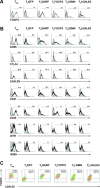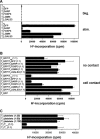GARP: a key receptor controlling FOXP3 in human regulatory T cells
- PMID: 19453521
- PMCID: PMC4516490
- DOI: 10.1111/j.1582-4934.2009.00782.x
GARP: a key receptor controlling FOXP3 in human regulatory T cells
Abstract
Recent evidence suggests that regulatory pathways might control sustained high levels of FOXP3 in regulatory CD4(+)CD25(hi) T (T(reg)) cells. Based on transcriptional profiling of ex vivo activated T(reg) and helper CD4(+)CD25(-) T (T(h)) cells we have identified GARP (glycoprotein-A repetitions predominant), LGALS3 (lectin, galactoside-binding, soluble, 3) and LGMN (legumain) as novel genes implicated in human T(reg) cell function, which are induced upon T-cell receptor stimulation. Retroviral overexpression of GARP in antigen-specific T(h) cells leads to an efficient and stable re-programming of an effector T cell towards a regulatory T cell, which involves up-regulation of FOXP3, LGALS3, LGMN and other T(reg)-associated markers. In contrast, overexpression of LGALS3 and LGMN enhance FOXP3 and GARP expression, but only partially induced a regulatory phenotype. Lentiviral down-regulation of GARP in T(reg) cells significantly impaired the suppressor function and was associated with down-regulation of FOXP3. Moreover, down-regulation of FOXP3 resulted in similar phenotypic changes and down-regulation of GARP. This provides compelling evidence for a GARP-FOXP3 positive feedback loop and provides a rational molecular basis for the known difference between natural and transforming growth factor-beta induced T(reg) cells as we show here that the latter do not up-regulate GARP. In summary, we have identified GARP as a key receptor controlling FOXP3 in T(reg) cells following T-cell activation in a positive feedback loop assisted by LGALS3 and LGMN, which represents a promising new system for the therapeutic manipulation of T cells in human disease.
Figures






References
-
- Ziegler SF. FOXP3: of mice and men. Annu Rev Immunol. 2006;24:209–26. - PubMed
-
- Fontenot JD, Rudensky AY. A well adapted regulatory contrivance: regulatory T cell development and the forkhead family transcription factor Foxp3. Nat Immunol. 2005;6:331–7. - PubMed
-
- Lin W, Haribhai D, Relland L, et al. Regulatory T cell development in the absence of functional Foxp3. Nat Immunol. 2007;8:359–68. - PubMed
-
- Schubert LA, Jeffery E, Zhang Y, et al. Scurfin (FOXP3) acts as a repressor of transcription and regulates T cell activation. J Biol Chem. 2001;276:37672–9. - PubMed
Publication types
MeSH terms
Substances
LinkOut - more resources
Full Text Sources
Other Literature Sources
Molecular Biology Databases
Research Materials

